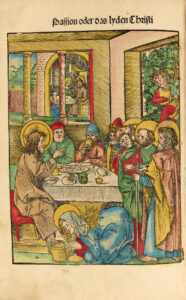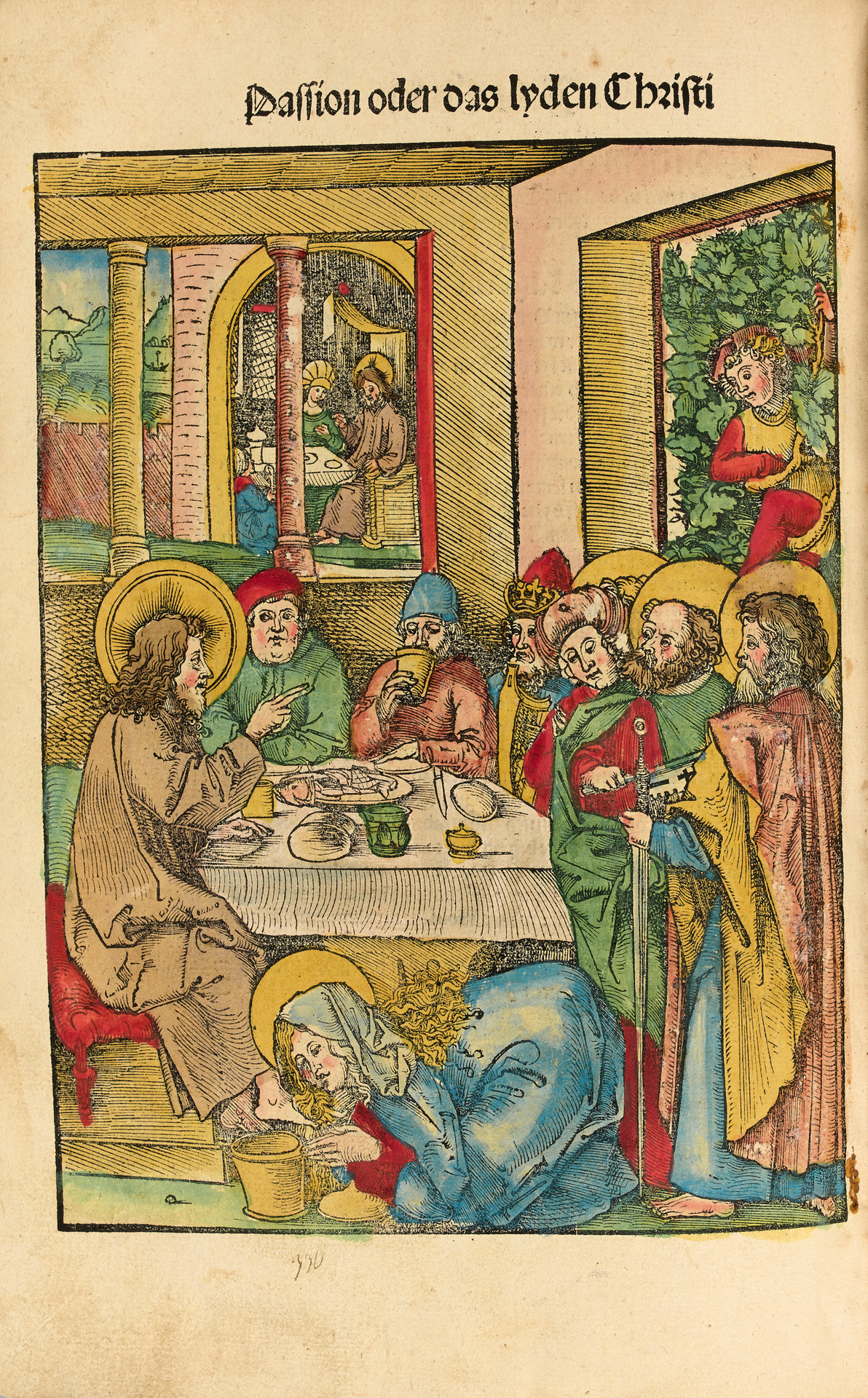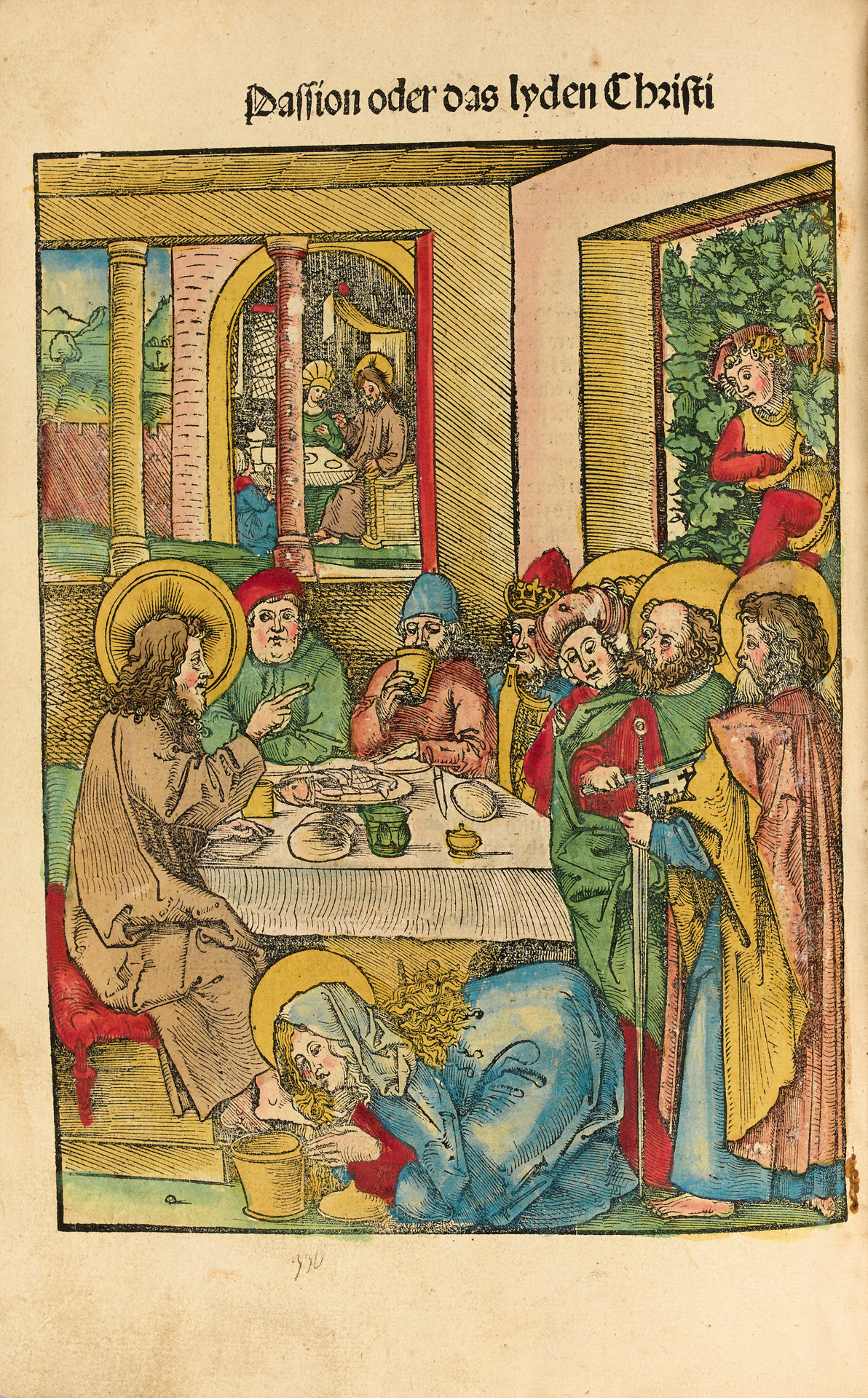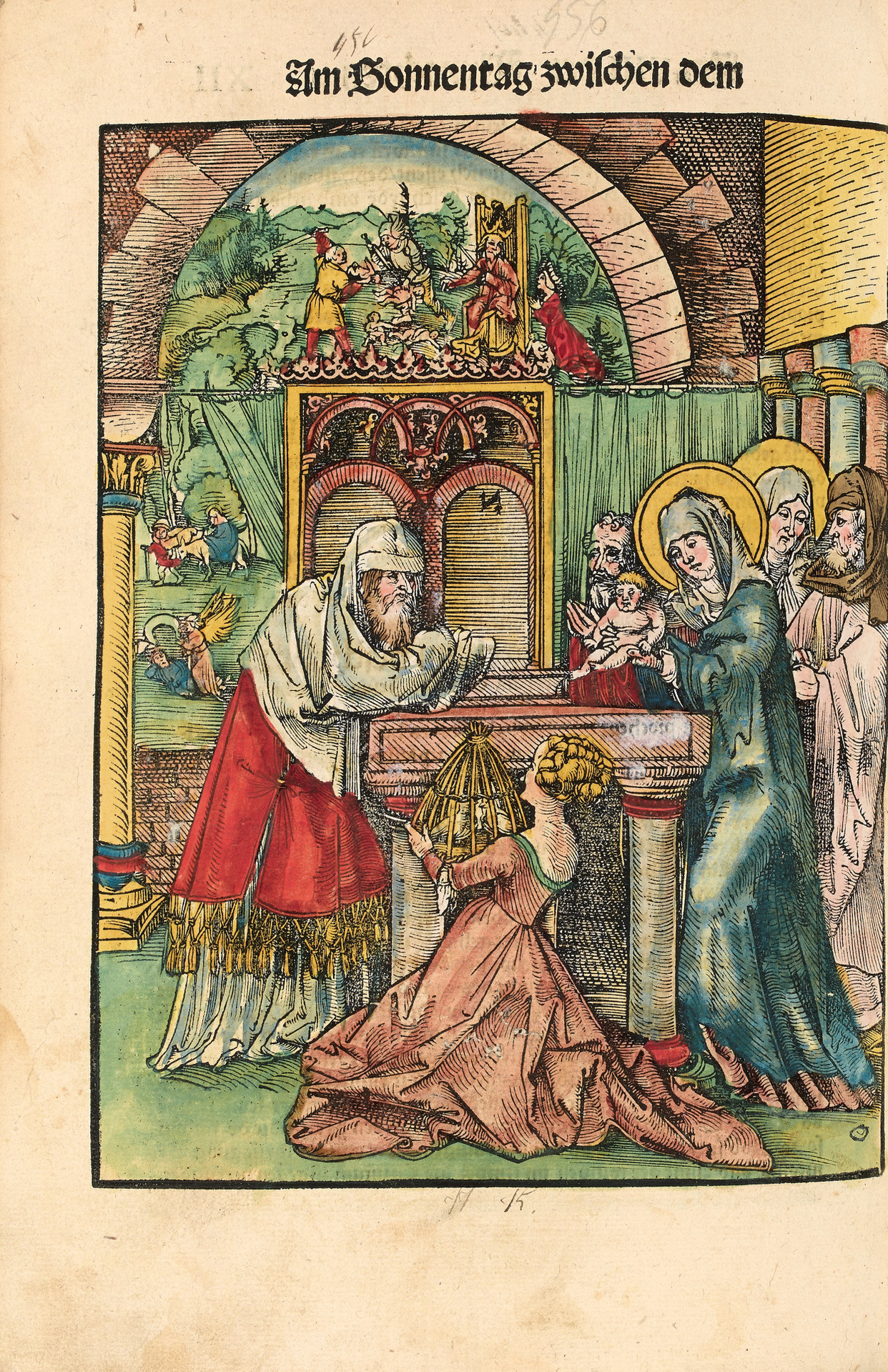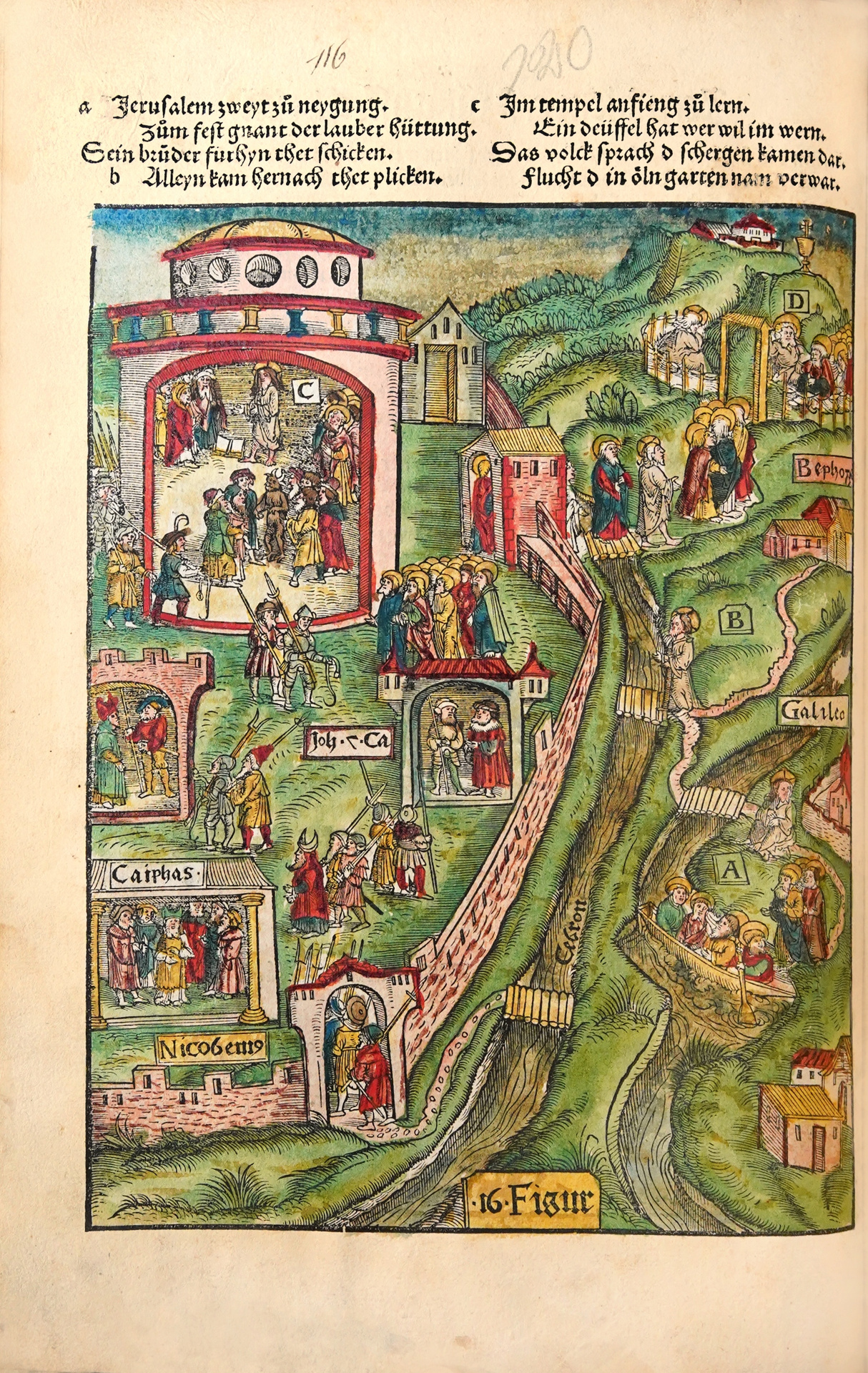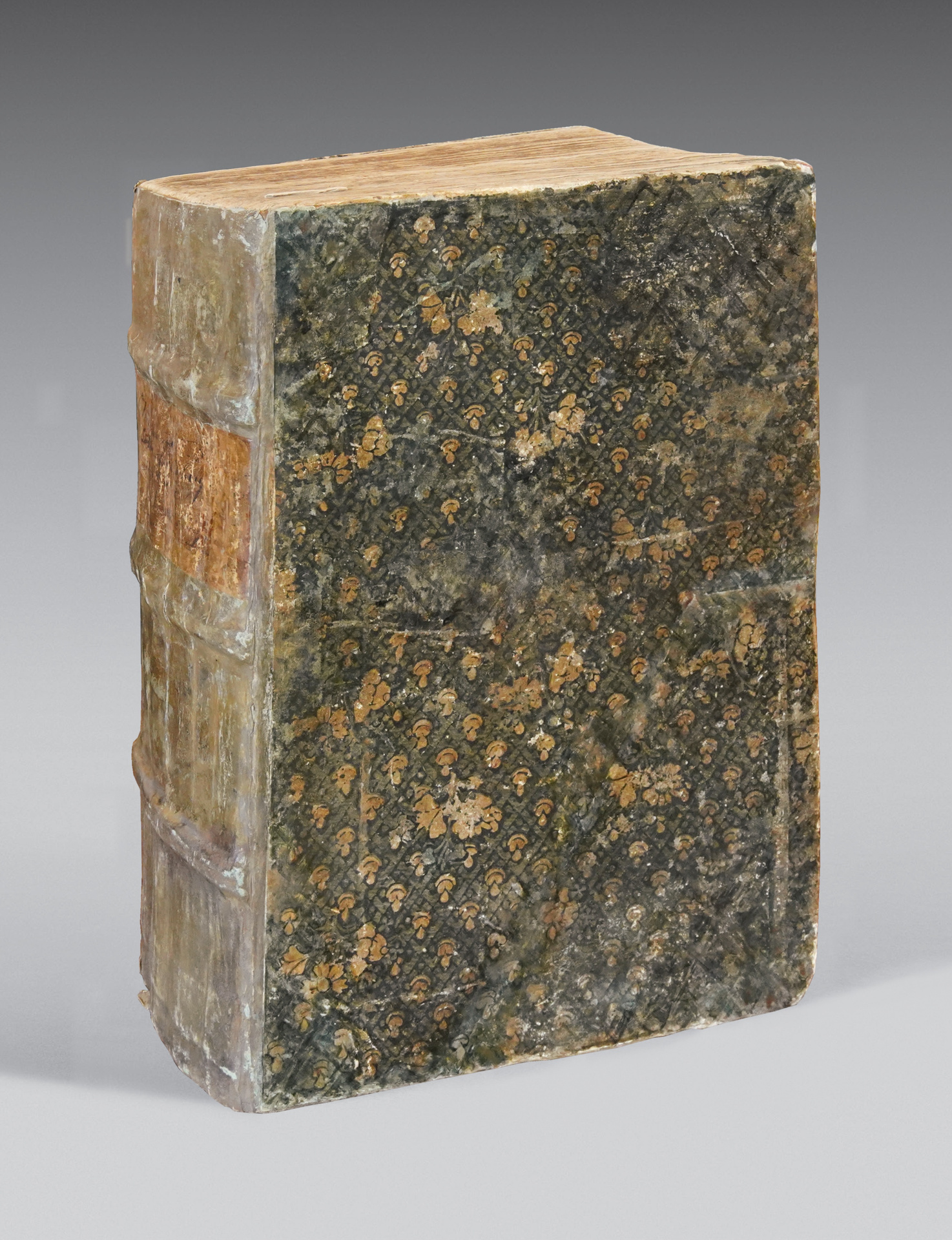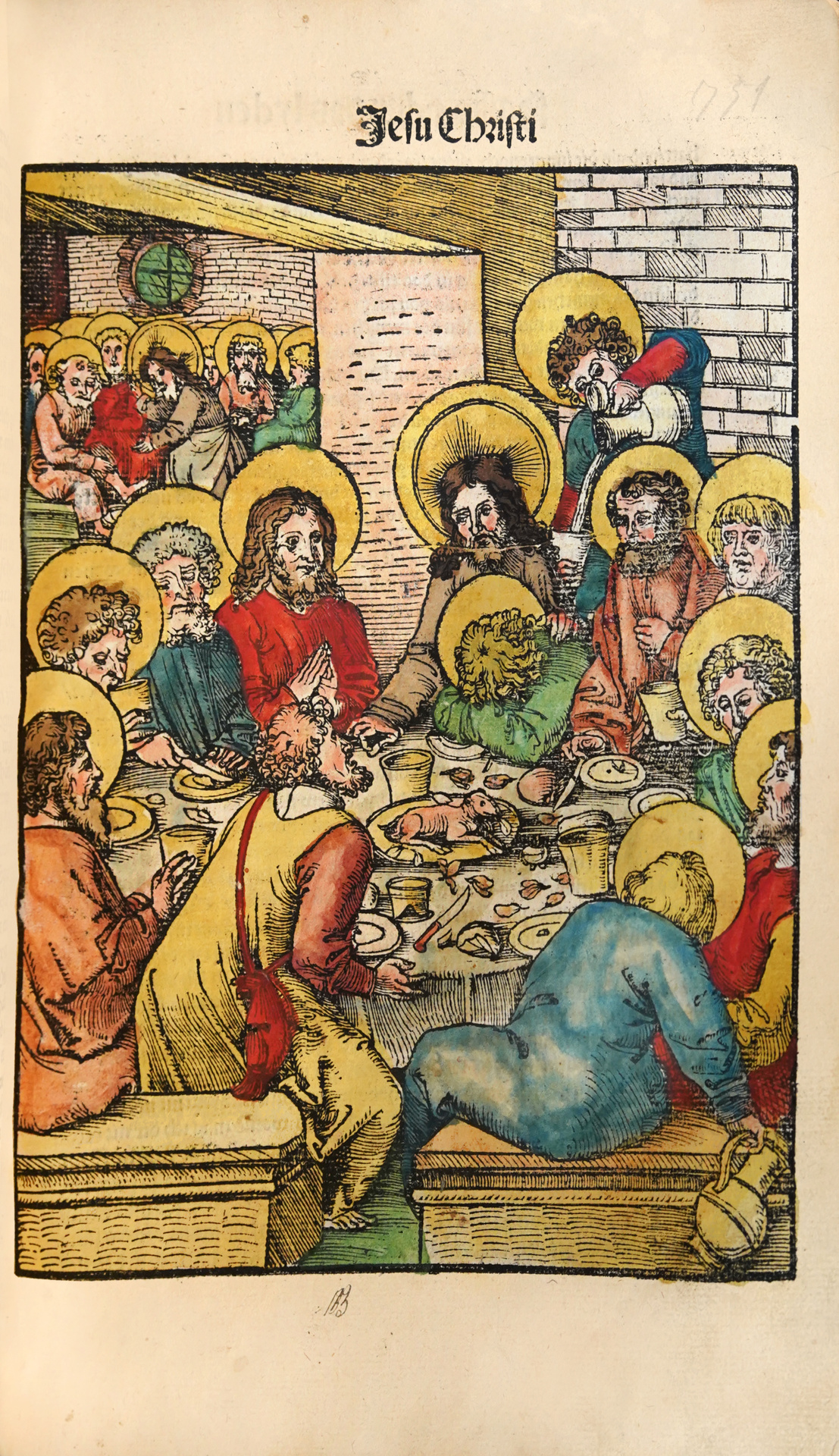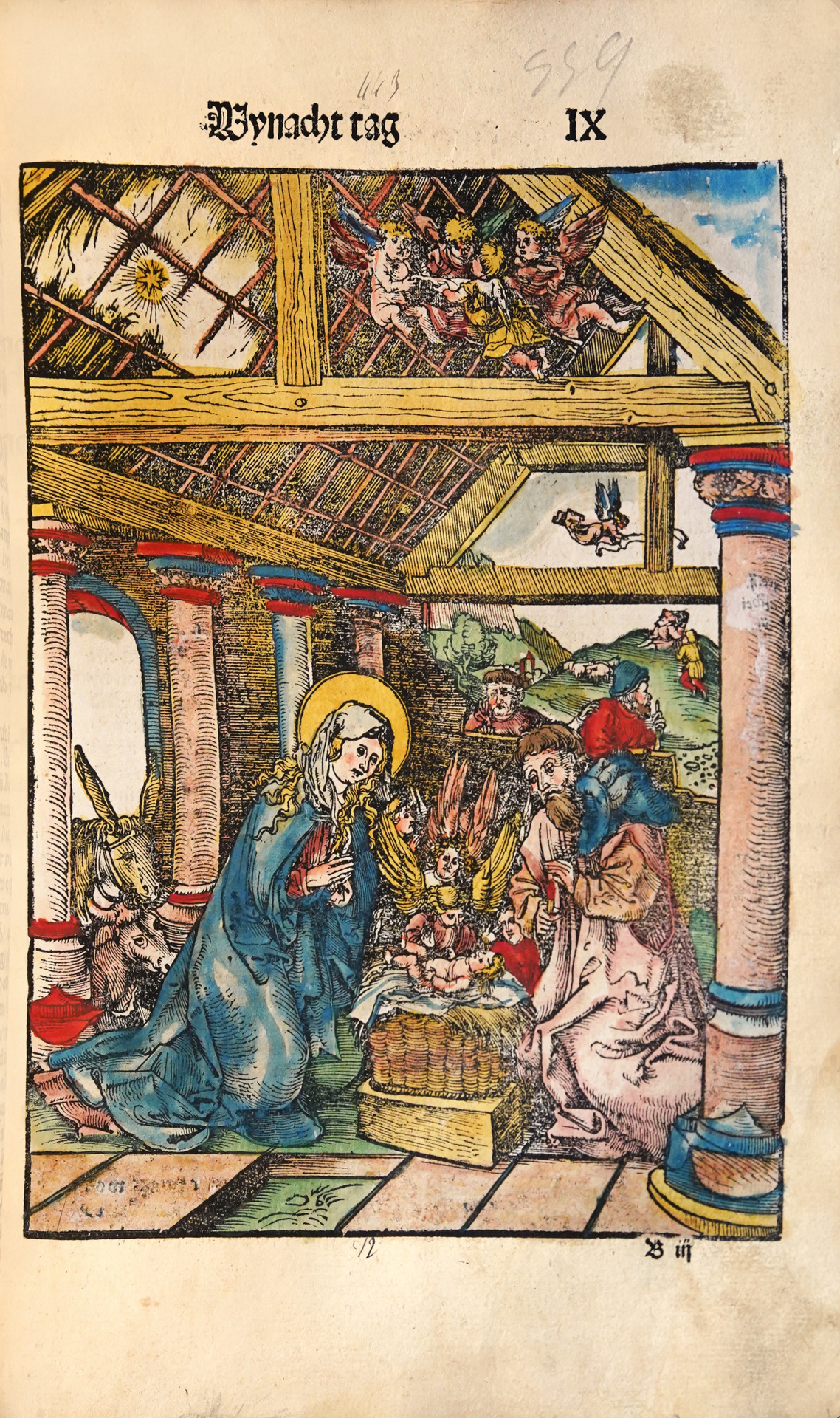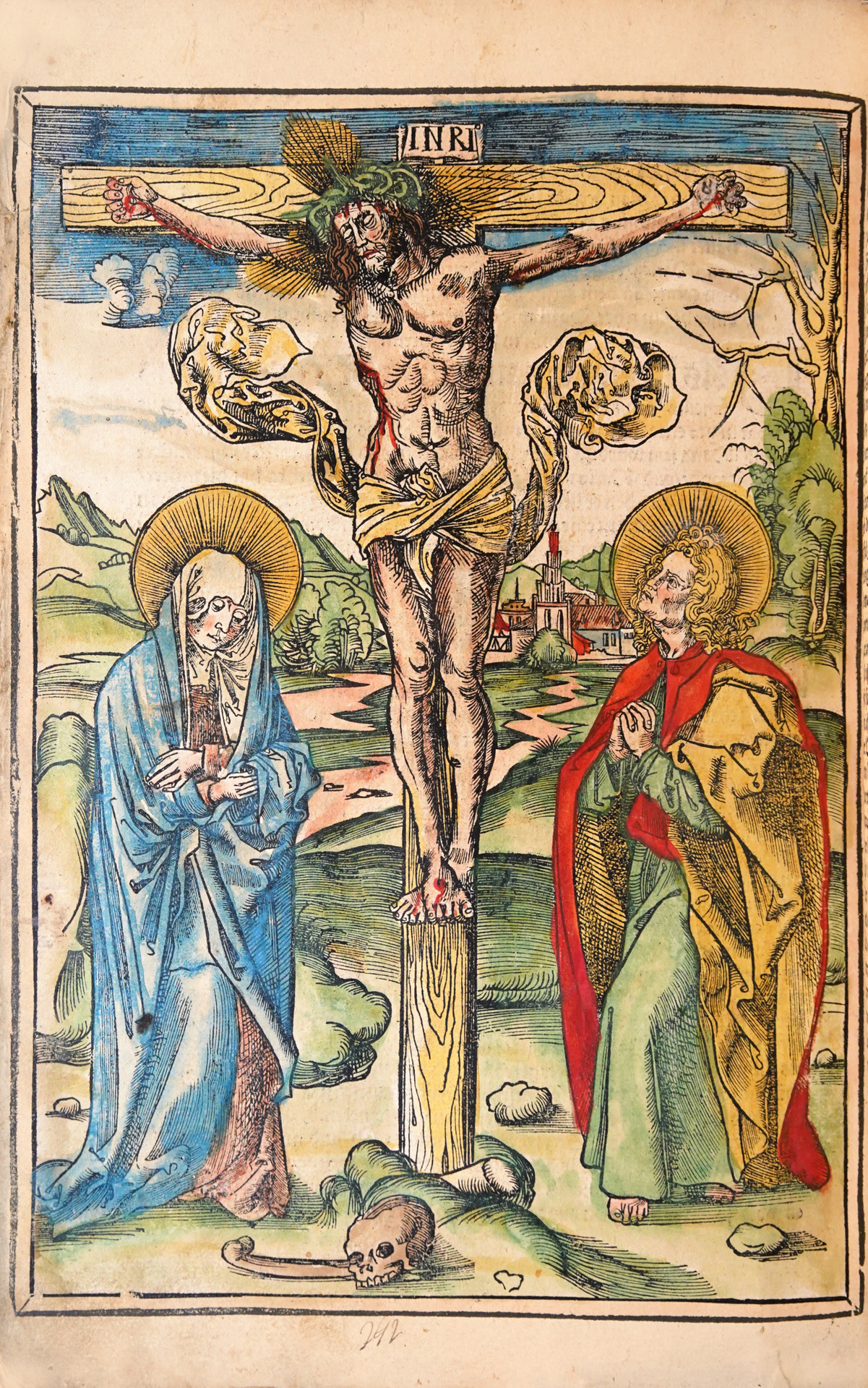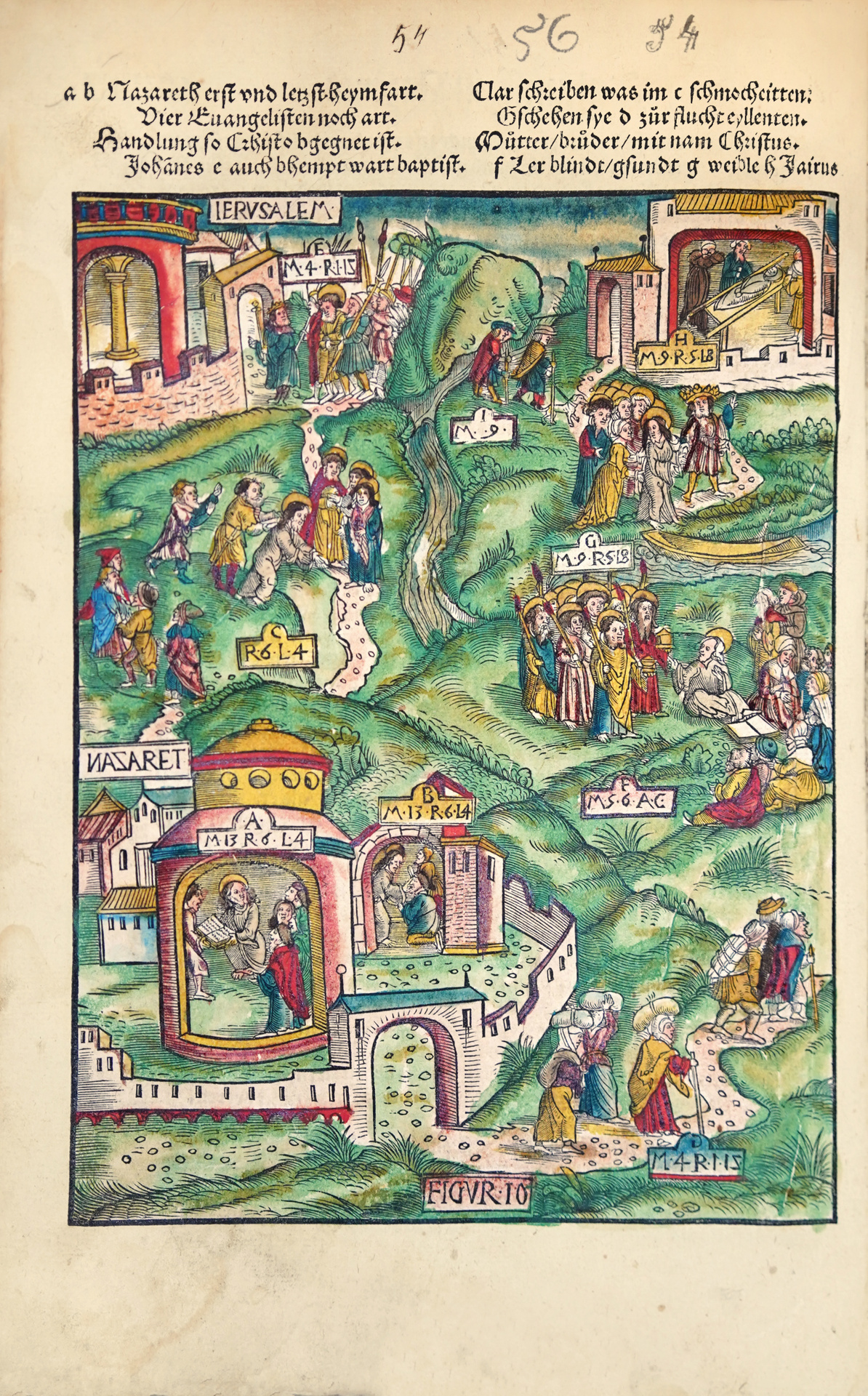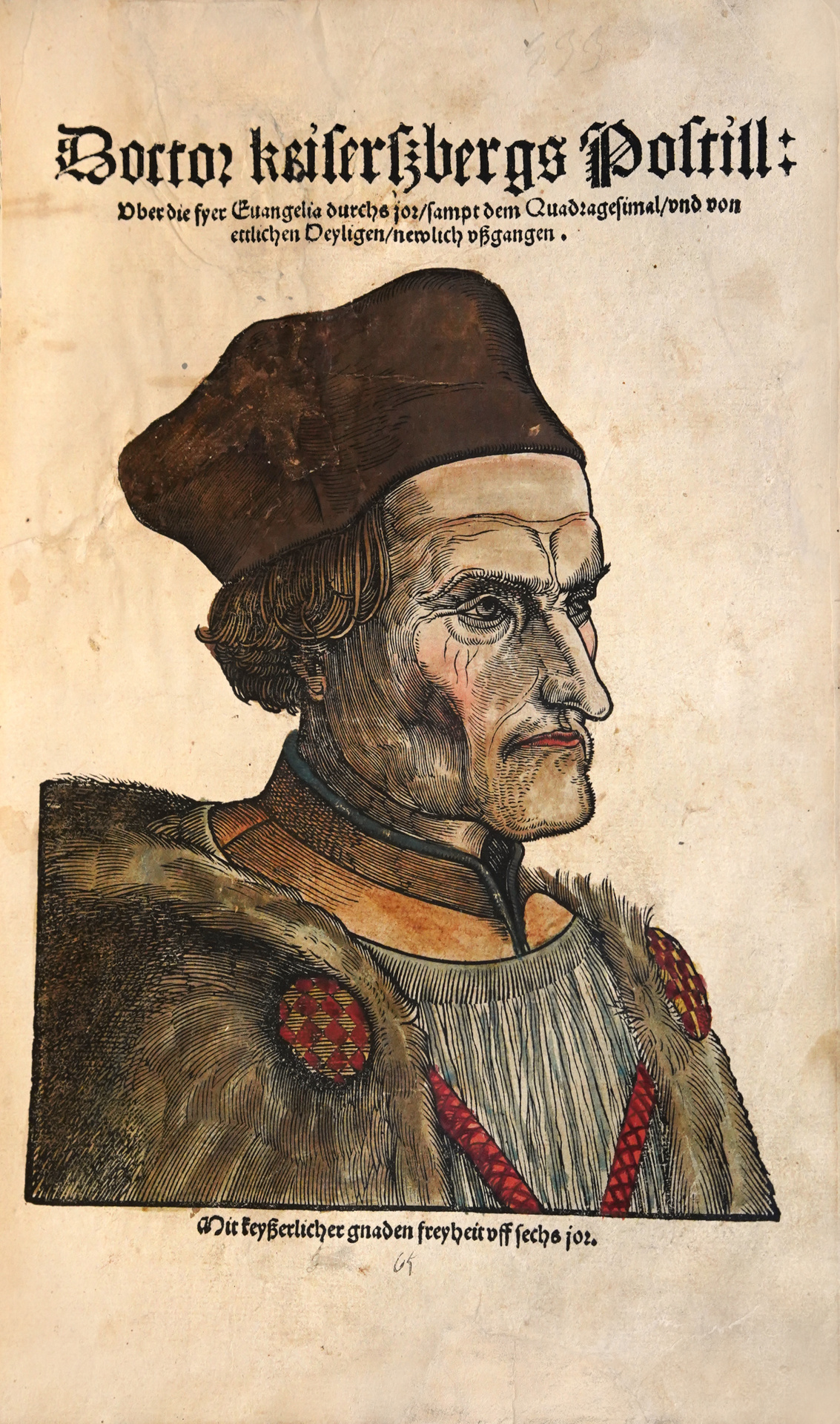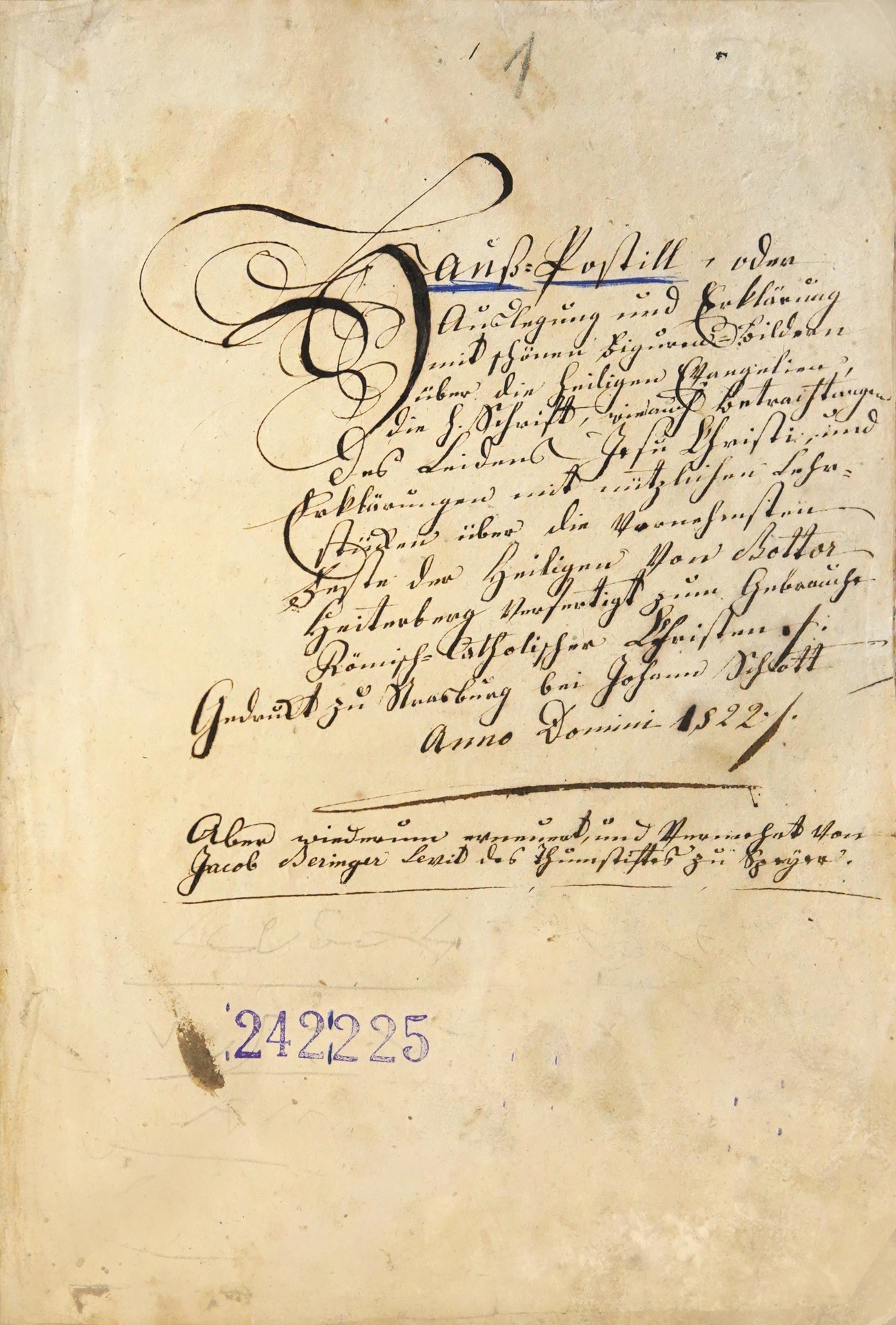Strasbourg : J. Schott, 1522.
Small folio [290 x 195 mm] of xxxv-cxvii ll., sign. a-d, cxx-xxxxi ll., woodcuts, portrait on the title, attributed to Wechtelin. [Postille on the four gospels for the whole yêr, Lent, and the celebrations of some saints.] 5 lêves missing, 327 lêves (of 332). Main têrings: part 1: title page is torn, half page missing lêf LXVIII, têring in text lêf E2 part 5.
Half-vellum, ribbed spine, decorated boards. Contemporary binding.
First edition illustrated with 142 woodcuts entirely hand colored in 1522 including the full-page portrait of Geiler, 41 full-page woodcuts and 100 woodcuts in the text. Geiler von Kaysersberg, famous prêcher, was born in Schaffhausen in 1445, but passed his childhood and youth from 1448 at Kaysersberg (Alsace) , and died in 1510 in Strasbourg. He studied philosophy and literature at Freiburg University in Breisgau, then theology in Basel. In 1478, he was walled up to Strasbourg as a prêcher. His reputation was grêt; he rose indignantly against the negligence and vices of the monks in a pictorial language and image which at the time caused têrs of admiration and that would today appêr as baroque and tasteless. His prêching led to the abolition of certain Catholic ceremonies contrary to the dignity of divine worship. The Chapel Saint-Laurent, where Geiler von Kaysersberg prêched, becoming too small due to his fame, they built in 1486 the magnificent pulpit decorated by Hans Hammer that we can still see today in the Cathedral of Strasbourg. Superb illustration, mainly by Hans Wechtlin, composed of a large portrait of Geiler on the title, 41 large full-page woodcuts (8 of these plates are repêted, so 32 original woodcuts), and 100 woodcuts (quarter page or smaller), certain repêted. “The art of Hans Wechtlin, artist cited at the beginning of the 16th century in the archives of the city of Strasbourg, is only known for the series of 43 woodcuts representing the different episodes of the life of the Virgin and the life of Christ. These engravings never appêred in the same book and the first of them to have been printed is in a work of 1506 (…) off the presses of Johann Knobloch (…). Subsequently, and apart from two exceptions that can be explained by a punctual loan, all the woodcuts are in the possession of the printer Johann Schott. (…) Given the strength of these images and the impact they have on the faithful, it isn’t a surprise that Johann Schott êsily used these woodcuts again to illustrate other religious texts (…). Hans Wechtlin was a German Renaissance artist, active between at lêst 1502 and 1526, whose woodcuts are his only certainly surviving work. He was the most prolific producer of German chiaroscuro woodcuts, printed in two or more colours, during their period in fashion, though most of his output was of book illustrations. He was born in about 1480-85, presumably in Strasbourg, then in Germany and now in France, where his father, also called Hans Wechtlin, was a cloth merchant. Most of his identified works are woodcut book illustrations, the first, scenes from the Life of Christ, are from a Strasbourg book of 1502, and the last is a Strasbourg title-page of 1526. In 1505 he began a yêr of employment as a painter to René II, Duke of Lorraine in Nancy. After he left Nancy he was in Wittenberg in 1506‑1507, where he must have met the court painter, Lucas Cranach the Elder. He became a citizen of Strasbourg in 1514, and by 1519 was a master of the painter’s guild there. He left nineteen single-lêf wood-cuts (i.e. prints rather than book illustrations), apparently made in the period 1505-15, and is mainly remembered for his twelve chiaroscuro woodcuts, which are all extremely rare. The dating of these has been much discussed by art-historians, as part of the very tangled issue of the development of the German chiaroscuro woodcut. Bartrum assigns them "towards the end" of the 16th century. No surviving paintings are attributed to him, although a few drawings have been, tentatively. As with most artists in woodcut, art historians now consider that Wechtlin probably just designed the woodcuts, lêving the block-cutting to a specialist "formschneider" who pasted the design to the wood and chiselled the white arês away. The quality of the final woodcuts, which varies considerably, depended on the skill of the cutter as well as the artist. His best known print is the chiaroscuro Skull Within an Ornamental Frame, "by far his most impressive" and "one of the most powerful [images] of the German Renaissance", which is the only one for which there is evidence of dating, as it is copied in a book of 1512. Four of his chiaroscuro prints are somewhat ostentatiously classical, two on the very obscure subjects of Alcon Slaying the Serpent and Pyrgoteles (a famous Ancient Greek gem-carver), as well the better known ones of Pyramus and Thisbe and Orpheus. They show Italianate influence, especially from the engravings of Marcantonio Raimondi, from whom the figures of Pyramus and Thisbe are directly borrowed. His woodcut technique is based on that of Albrecht Dürer, though his wooded backgrounds owe more to Cranach. His Knight and Halberdier is in the chivalrous spirit influenced by Emperor Maximilian and his calls for a crusade; indeed the style of armour the knight wêrs is often called "Maximilian armour". Other êrly chiaroscuro woodcuts were equestrian portraits of similar knightly figures, a portrait of Maximilian by Hans Burgkmair, and versions of Saint George and the Dragon looking very similar to the Emperor, by both Cranach and Burgkmair. Wechtlin's twelve prints were the largest individual contribution to the corpus of about sixty German chiaroscuro woodcuts from the êrly 16th century - the technique was probably invented by Burgkmair in 1508. Unlike Burgkmair's often frankly garish colours, Wechtlin's colour woodcuts use only two blocks and muted colours. In both the Cleveland and Cincinnati impressions of the Knight and Halberdier there are black line blocks and a "greyish-blue" tone block; other tone blocks are described as "blue-grey" (Orpheus and the Skull) and "grey-green" (Pyramus and Thisbe). His monogram, used only on eleven of his chiaroscuro prints, consists in its fullest form of his initials "Io V" between two diagonally crossed pilgrim's staves, with a flower in the centre, on a cartellino or plaque, a style copied from Albrecht Dürer. His prints, recognised as a group, remained unattributed to any documented artist until 1851, when his name on the title page of a book he illustrated was connected with the monogram and the few documentary records. A similar monogram was used by the glass-painter Jacob Wechtlin, perhaps a brother. His best known book illustrations in his own time were 135 woodcuts from Sebastian Brant's 1502 edition of Virgil's Aeneid, "perhaps the most influential book illustrations ever produced in Europe", though the attribution to him is not universally agreed. This was the first printed Virgil with illustrations. These crowded compositions retain many Gothic fêtures, compared for example with Botticelli's rather êrlier painted illustrations to Dante. They were copied in many other book editions and about thirty yêrs later in a famous series of Limoges enamel plaques by the "Master of the Aeneid Series", one of many such derivative works. Better-known today are the often rather gruesome woodcuts for Hans von Gersdorff's (1455‑1529) Feldtbuch der Wundartzney (literally "Field-book of the Wound-doctor", 1517, 1st edn.), a manual for the military surgeon (see Commons). These have sometimes been coloured by hand, but are printed in black and white. His frontispiece for the 1526 edition, produced when he was probably in his forties, is the last known trace of him. He is not to be confused with Hans Weiditz, another Strasbourg woodcut artist of the period. At the beginning of the volume is bound: Beringer, Jacob. Das Nüw Testament kurtz und grüntlich in ein Ordnung und Text die vier Evangelisten mit schoenen Figuren durch auss geführt sampt den anderen Apostolen : und in der keiserlichen Stat Speyer volendet durch Jacobum Beringer Leuiten. Strasbourg, Johann Schott, 1527. Folio of 217 ll., 65 large full-page contemporary illuminated woodcuts, title, ll. xii, xiii and ccv with 2 woodcuts are missing. First edition of the New Testament, in Lutheran translation, “harmonized” by Jacob Beringer, chaplain of the Speyer Cathedral and Lutheran supporter. The work is illustrated with 63 large full-page woodcuts in contemporary colors, some of which credited to Henrich Vogtherr (1490-1556). 5 of these illustrations were blacked out because of nudity scenes or representations of the devil… The dialectic is very present in Vogtherr, between the engaged art (religious propaganda) and the ornamental art (private enjoyment). – The artist’s belonging and loyalty to the Reformation without which “he would undoubtedly have remained an artist, or rather a second-rate craftsman”. - As Vogherr is also a writer, written sources are taken into consideration. Among the most interesting images for a student of the Bible and theologian, we should mention his collaboration with the Leieinbibel of 1540, a Bible entirely in images (186 plates), his 200 vignettes for the Bibel of Köpfel – die Gantz Bibel – (1529-1530) his visual metaphors of faith (The ship of the pilgrims; the gardener reformer), strange engravings as The deified man (Der vergottet Mensch), where texts and images interpenetrate in a kind of mystical profession of faith. In matter of image, the Reformation was not only iconoclastic; it was also iconographic, which mêns it used image as a writing. Exceptional volume of which the 205 engravings, 105 being full-page and 100 being in the text, were bêutifully hand-painted at the time of publication. First title : Bibliography : Dacheux 82. VD16 G 788. Alice Klein, les gravures d’illustration de Hans Wechtlin, peintre et graveur à Strasbourg à l’aube du XVIe siècle. Ritter 986. Illustration : 142 woodcuts (portrait about 19 x 16 cm, 41 woodcuts of about 21,5 x 16,5 cm, and 100 woodcuts of about 8 x 5 cm). Second title : Bibliography : Pietsch 114 Bibelsammlung der Wurttembergischen Landes-bibliothek, Stuttgart 1987, n° E 167 & 168 VD16 B 4378. Frank Muller, Heinrich Voghterr l’Ancien. Un artiste entre Renaissance et Réforme, pp.244 à 246. Ritter 2309. Illustration : 63 woodcuts (about 21 x 16 cm).
See less information
